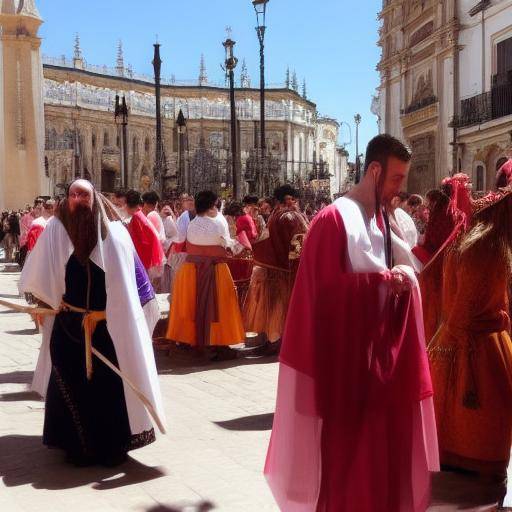
Easter in Seville is one of the most emblematic celebrations in Spain. During this week, Seville is filled with religious fervor, tradition, music and color, attracting thousands of visitors from around the world. In this article, we will explore the processions, steps, and arrows, which are an integral part of this holiday, offering a detailed view of its origins, meanings, current practices, as well as practical advice and predictions for the future.
Introduction to Holy Week in Seville
Holy Week, which commemorates the passion, death and resurrection of Jesus Christ, is a celebration deeply rooted in the traditions of Spain. In Seville, this festival takes on a special magnitude, becoming a highlight of the cultural and religious calendar.
Processions: The Soul of Holy Week
The processions are the center of the Holy Week in Seville. Brotherhoods and brotherhoods travel through the streets of the city taking steps that represent scenes of Christ's passion. Processions are a manifestation of faith, devotion and tradition, and each one has its own journey, music and distinctive style.
Steps: Art in Movement
The steps, religious sculptures usually carved in wood, are transported on the shoulders of the ribs, creating an impressive show that merges art, religion and devotion. Each step is a masterpiece carved by renowned artists, and its parade through the streets of Seville is an event revered by locals and visitors alike.
Saetas: Song from the Soul
The saetas are flamenco songs of deep emotivity, spontaneously tuned by the fans during the processions. These songs, loaded with intensity and passion, express devotion and pain to the images that pass. The arrows add a unique emotional dimension to the Solemnity of Holy Week in Seville.
History and Meaning
The Holy Week in Seville has its roots in the Middle Ages, and over the centuries has evolved to become the great celebration that is today. The processions, steps and arrows have a profound religious and cultural meaning, transmitted from generation to generation, merging Catholic faith with Andalusian identity.
Current Benefits and Challenges
Despite its longstanding tradition, processions also face modern challenges, such as crowd management, preservation of artistic heritage and adaptation to contemporary expectations. However, the fervent devotion and cultural pride represented by the processions remain a vital link to the Sevillian community.
Comparison between Processions, Steps and Saetas
Although every aspect of Holy Week in Seville is distinctive, all converge in a common purpose: to celebrate the passion, death and resurrection of Jesus Christ. Processions, steps and arrows complement each other, weaving a tapestry of emotions and traditions that captivate those who witness them.
Future Councils and Observations
If you plan to witness the Holy Week in Seville, it is essential that you prepare yourself for an intense and moving experience. Be sure to plan ahead, respect local customs and be open to the deep spirituality that permeates every detail of this celebration.
Future Expert and Vision Perspectives
Experts on cultural heritage and anthropology point out the importance of preserving the traditions of Holy Week in a constantly changing world. They also predict that the influence of Holy Week on Sevillian identity will remain fundamental in the coming decades.
Conclusion
Holy Week in Seville is an unforgettable experience that combines devotion, tradition, art and music in a unique show in the world. Experience the intensity of the processions to immerse in a celebration that transcends the religious to become a living expression of the spirit and identity of Seville. If you have the opportunity to live this experience, you will not regret it.
FAQs
1. What is the origin of the Holy Week processions in Seville?
The processions of Holy Week in Seville have their roots in the Middle Ages, when religious brotherhoods began to parade through the streets to commemorate the Passion of Christ.
2. What represent the steps taken in the processions?
The steps represent scenes of the passion, death and resurrection of Jesus Christ, carved in impressive wood or metal sculptures by renowned artists.
3. What is the meaning of the arrows in Holy Week?
The arrows are spontaneous flamenco songs tuned during the processions, expressing devotion and intense emotions to the religious images that pass.
4. What should I take into account if I want to witness Easter in Seville?
It is important to respect local customs, to be informed about the times and journeys of processions, and to be prepared to experience an exciting and moving experience.
5. What role do the coasters play in the Easter processions?
The coasters are responsible for taking the steps to shoulder, showing an extraordinary physical skill and a devout commitment to their brotherhood and faith.
6. What is the importance of Holy Week for Sevillian Identity?
Holy Week is a fundamental part of Sevillian identity, merging Catholic faith with culture, art and tradition, being a symbol of pride for the local community.
Holy Week in Seville is a unique celebration that captivates all those who are lucky to witness it. The fusion of art, music, tradition and spirituality creates a unique atmosphere that leaves a deep impression on all those involved. If you have the opportunity to immerse yourself in this experience, do not hesitate to do so.
